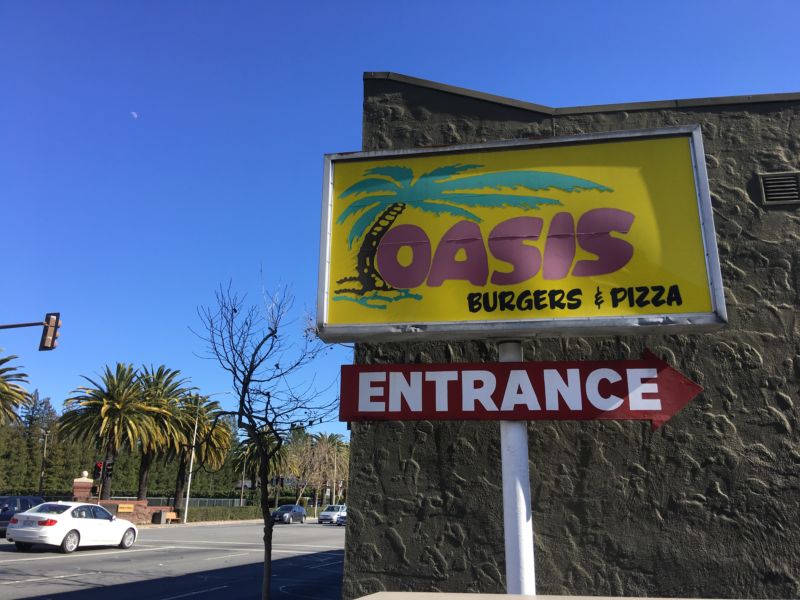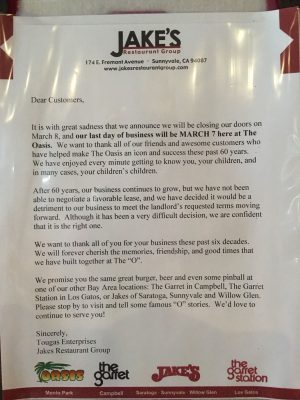
MENLO PARK, Calif.—An iconic, family-run burger-and-pizza pub that has been operating in the heart of Silicon Valley for 60 years announced this week that it would close for good on March 7 due to an unaffordable rent.
In addition to being a local favorite, The Oasis Beer Garden—a short drive away from nearby Stanford University—also has a special place in the hearts of many of the region’s early tech pioneers.
Members of the legendary Homebrew Computer Club—a 1970s-era monthly club that met in the early days of personal computing—would often relocate to "The O" as the night wore on.
“[Going to The Oasis] was considered an extension of the meeting—of the random access period,” Lee Felsenstein, an original Homebrew member, told Ars on Friday. “We filled the whole room—starting from the left corner booth.”
Felsenstein, who still lives and works in the Bay Area, is best known for having designed the Osborne 1, the first portable and commercially successful microcomputer, which was released in 1981.

Thousands have already signed an online petition in an attempt to save it from closing, and a local city official said he would do what he could.
“It’s for families,” Menlo Park Mayor Pro Tem Ray Mueller texted the San Jose Mercury News. “It’s where you celebrate your baseball and soccer team’s win or where you meet your friends to watch the championship game... The potential loss of The Oasis is significant to our community... It’s an institution. The timeline is short for closure, but I am going to do my best.”
Steven Levy’s 1984 book, Hackers, chronicles how Homebrew members would continue their meetings until midnight at The Oasis, described as a “a raucous watering hole” near Stanford.
Piling into wooden booths with tables deeply etched with the initials of generations of Stanford students, Garland and Melen and Marsh and Felsenstein and Dompier and French and whoever else felt like showing up would get emboldened by the meeting’s energy and the pitchers of beer. They would envision developments so fantastic that no one ever believed they could be more than fantasies, far-flung fancies like the day when home computers with TV displays would engender pornographic programs SMUT-ROMs, they called them which would not be illegal because they’d only be pornographic if you scanned them the way the computer did. How could the raw computer code be pornographic? It was just one of dozens of perversely improbable musings that would be not only realized but surpassed within a few years.
Roger Melen, a Homebrew member who is credited with originally suggesting that members relocate to the bar, said that the Levy passage matches his memory of the place.
“I think the beer would tend to cause people to share their wild concepts and social ideas,” he told Ars, adding that he always found the after-hours discussions to be "more interesting" than the formal Homebrew meetings initially held at a nearby auditorium at the Stanford Linear Accelerator Center.
-
The O's front door leads into a dark, cavernous room.Cyrus Farivar
-
The O's pizzas are legendary.Cyrus Farivar
-
This was Ars' Friday lunch order.Cyrus Farivar
-
Inside, the bar has a full assortment of beer and wine. On a Friday afternoon around 3pm, all the bar stools were full.Cyrus Farivar
-
The Oasis was doing brisk business, even two weeks before its closing date.Cyrus Farivar
-
Many local patrons are mourning the loss of their favorite pub.Cyrus Farivar
-
In case you needed an explainer for "steam beer,' here's one.Cyrus Farivar
-
An example of wall art at The Oasis.Cyrus Farivar
-
At least one Oasis fan made it to CERN in Switzerland.Cyrus Farivar
-
Even in 2018, there's still a wooden sign proudly advertising "Free Wi-Fi."Cyrus Farivar
-
The Oasis was even popular with at least three NASA astronauts.Cyrus Farivar
-
The Oasis has served generations of Stanford fans and alumni.Cyrus Farivar
-
There are also icons of other Pac-12 sports teams.Cyrus Farivar
-
The walls have lots of old Stanford memorabilia.Cyrus Farivar
-
It's easy to imagine '70s-era nerds hanging out here.Cyrus Farivar
-
A successful meal.Cyrus Farivar
“That’s not packed”
Ars overhead some patrons say that they came in to grab a t-shirt or one more burger before the closure. We observed people from all walks of life: young couples, teenagers, middle-aged men watching sports on TV, an older man reading the sports page of the San Francisco Chronicle while nursing a Coors, and a middle-aged woman wearing a Stanford hoodie who had just arrived for the first time even though she’d driven past the pub for 20 years.
Nearly everyone we could see had a smartphone in hand.
The Oasis is a fairly large square room with dark wood paneling, a small video arcade in the corner, and semi-private booths that could probably seat six people along the perimeter. It has an extensive menu of pizzas, salads, burgers, wine, beer, and an outside patio on which to enjoy all of it. The walls are adorned with various sports memorabilia, particularly Stanford football, some going back over a century. There are extensive wood carvings and marker graffiti all over the place.
When Ars sent Felsenstein a picture of the Friday afternoon scene and described it as “packed,” he immediately wrote back.
“No,” he wrote. “That’s not packed—what’s packed is when we filled every seat on both sides of every table and half of us couldn’t get out to the grill to place an order. One guy across from me asked me to take his hot dog order. I had been drinking steam beer bought by others so I told him ‘I’ll buy your dog!’ and I did.”
Felsenstein added that he had a standard order at The O.
“I think it was a burger, maybe with bacon—probably with cheese,” he wrote. “I can’t remember for sure. We all ate peanuts and left the shells on the table, sweeping them to the floor when we left. Good to soak up any spilled Anchor Steam Beer.” (Ars ordered a pint of Trumer Pils, a cheeseburger, and fries. With tax and tip, our bill came to $20.)
When Ars texted Steve Wozniak, who was a Homebrew member before he went on to co-found Apple, what his memories of The Oasis were, he regretted that he had none.
“Never went there myself,” he wrote. “Had never drunk alcohol and was shy, so no pubs.”
But, he added: “I’m sure the conversations there were important in my own inspiration.”
reader comments
103